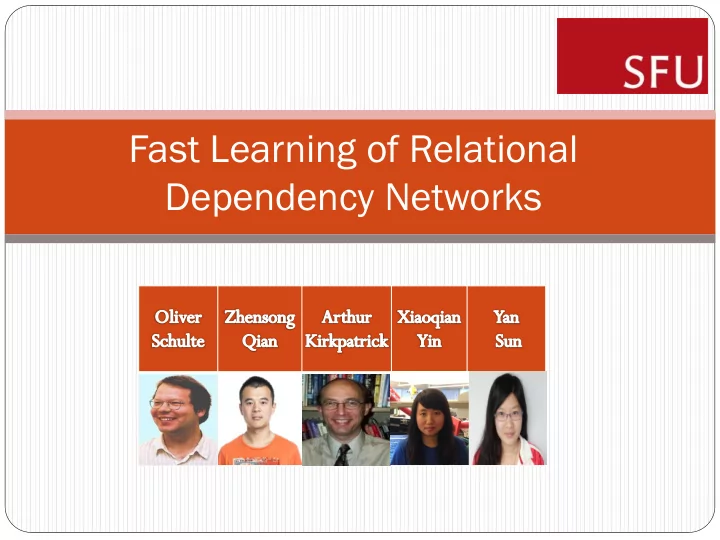

Fast Learning of Relational Dependency Networks
Relational Dependency Networks B in Person • Structure: Directed graph, gender(B) cycles are allowed. • Parents of Node = Friend(A,B) Markov Blanket of Node. • Parameter = gender(A) distribution of child given parents. CoffeeDr(A) • Accommodates relational A in Person autocorrelations. Neville, J. & Jensen, D. (2007), 'Relational Dependency Networks', Journal of Machine Learning Research 8, 653--692. 2/14
Overview Task: learn relational dependency network structure + parameters our new previous approach approaches single generative model multiple discriminative models fast learning Bayesian network independently learned e.g., 1 min for 1M records. (one for each predicate) new closed-form transformation method Convert Bayesian network to Relational Dependency Network 3/14
From BN Structure To DN Structure Solid arrows = Bayesian Network Solid + dash arrows = Dependency Network gender(B) Friend(A,B) gender(A) CoffeeDr(A) Heckerman, D.; Chickering, D. M.; Meek, C.; Rounthwaite, R.; Kadie, C. & Kaelbling, P . (2000), 'Dependency Networks for Inference, Collaborative Filtering, and Data Visualization', Journal of Machine Learning Research 1, 49 — 75. 4/14
From BN Parameters to DN Parameters Log-linear model for probability of target instance given its Markov blanket. Example: Predict the gender of Sam, given that 40% of Sam’s friends are Women, and Sam is a coffee drinker. DN Parameter P(target = value|Markov blanket) ∝ exp {∑ target instance + children ∑ parent values PV , child values CV ln(P(CV|PV)) ∙ frequency(CV ,PV) } BN Parameter Markov Blanket 5/14 Fast Learning of Relational Dependency Networks
Example Predict the gender of Sam, given that 40% of Sam’s friends are Women, and Sam is a coffee drinker: CP log(CP) Rel. log(CP) gender(B) Friend(sam,B Child Value Parent State Freq. * Freq. ) g(sam) = W g(B) = W , 0.55 -0.60 0.40 -0.24 F(sam,B) = T gender(sam) g(sam) = W g(B) = M, 0.37 -0.99 0.60 -0.60 F(sam,B) = T cd(sam) = T g(sam) = W 0.80 -0.22 1.00 -0.22 cd(sam) = F g(sam) = W 0.20 -1.61 0.00 0.00 CoffeeDr(sam) Sum{ EXP(Sum) ∝ P(gender(sam)=W|MB) } -1.06 P(g(A) = W | g(B) = W, F(A,B) = T) =0.55 P(g(A) = M | g(B) = M, F(A,B) = T) = 0.63 P(cd(A) = T|g(A) = M) = 0.6 P(cd(A) = T|g(A) = W) = 0.8 6/14
Evaluation Metrics Running time Conditional Log Likelihood (CLL) How confident we are with the prediction Area Under Precision-Recall Curve (PR) For skewed distributions. Results are averaged over 5-fold cross-validation, over all two-class predicates in the dataset. Comparison Methods: RDN-Boost, MLN-Boost. Natarajan, S.; Khot, T.; Kersting, K.; Gutmann, B. & Shavlik, J. W . (2012), 'Gradient-based boosting for statistical relational learning: The relational dependency network case', Machine Learning 86(1), 25-56. 7/14
Accuracy Comparison RDN_Boost MLN_Boost RDN_Bayes 1.20 1.00 0.80 PR 0.60 0.40 0.20 0.00 UW Mondial Hepatitis Muta MovieLens(0.1M) 0.00 -0.10 -0.20 -0.30 CLL -0.40 -0.50 -0.60 -0.70 8/14
Learning Time Comparison Dataset # Predicates # tuples RDN_Boost MLN_Boost RDN_Bayes UW 14 612 15±0.3 19±0.7 1±0.0 Mondial 18 870 27±0.9 42±1.0 102±6.9 Hepatitis 19 11,316 251±5.3 230±2.0 286±2.9 11 Mutagenesis 24,326 118±6.3 49±1.3 1±0.0 MovieLens(0.1M) 7 83,402 44±4.5 min 31±1.87 min 1±0.0 MovieLens(1M) 7 1,010,051 >24 hours >24 hours 10±0.1 • Standard deviations are shown. • Units are seconds unless otherwise stated. 9/14 Fast Learning of Relational Dependency Networks
RDN-Bayes uses more relevant predicates and more first-order variables Our best predicate for each database: # extra # extra first Target predicate order Database Predicate s variables CLL-diff Mondial religion 11 1 0.58 IMDB gender 6 2 0.30 UW-CSE student 4 1 0.50 Hepatitis sex 4 2 0.20 Mutagenesis ind1 5 1 0.56 MovieLens gender 1 1 0.26 10/14 Fast Learning of Relational Dependency Networks
Structure Comparison Example IMDB UserID Occupation Age gender UserID MovieID Rating RDN-Boost MovieID Time 🎦 Model Target Markov Blanket RDN- gender(U) Occupation(U), RDN- Boost Age(U) Bayes ActorID MovieID RDN- gender(U) Occupation(U), Bayes Age(U), Rating(U,M), RunningTime(M), CastMember(M,X), ActorID AGender AGender(X) 11/14 Fast Learning of Relational Dependency Networks
Conclusions Basic Idea: convert Bayesian networks to relational dependency networks. fast BN learning ⇒ fast DN learning. dependency networks ⇒ inference with cyclic dependencies/autocorrelations. • New log-linear model for converting BN parameters to DN parameters. • I.e., define probability of a node given Markov blanket, Bayes net model. • Empirical evaluation • Scales very well with number of records. • Competitive accuracy with functional gradient boosting. 12/14 Fast Learning of Relational Dependency Networks
There’s More Empirical Comparisons counts instead of frequencies weight learning more on MLN-Boost Theorems about dependency network consistency 13/14 Fast Learning of Relational Dependency Networks
The End Any questions? 14/14 Fast Learning of Relational Dependency Networks
Recommend
More recommend